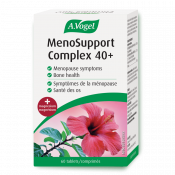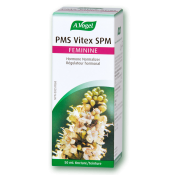Hormonal chaos
In childhood, there is no hormonal activity related to reproduction. This changes quite suddenly at puberty what seems like a chaotic hormonal explosion. The transition from beginning to end can take five-plus years. This is followed by years of monthly periods and relative hormonal balance – until hormonal chaos strikes again and eventually brings a woman to the end to child-bearing years. Like puberty, this reverse transition can take five-plus years until the body finds a new balance.
However, the rhythm of the menstrual years and the peace of the post-menopause years can quite easily be disrupted as well, due to the various influences on hormones from lifestyle, diet, stress, etc. Fortunately, these are all factors a woman can influence to a good extent if she has the knowledge and the tools. Firstly, let’s make sure we understand what we’re dealing with -
The menstrual cycle
Estrogen
During the first part of the menstrual cycle, estrogen levels rise as it oversees the thickening of the lining of the womb. Estrogen is also a mild antidepressant, good for the gut, fluid balance, bone density, memory, stimulating and the production of skin collagen – no wonder most women feel positive and happy by and large, hormonally speaking. Nature’s trick is that when it reaches its peak and triggers ovulation, women are at their most fertile and usually feel most like having sex.
Progesterone
After ovulation, in the second half of the cycle, progesterone levels rise. This protects the womb lining so that it’s ready for implanting a fertilized egg if needed. During the last week of the cycle, when it’s clear that no fertilized egg is arriving, levels of both estrogen and progesterone fall and the body prepares to shed the un-used womb lining in a bleed – or period. During the second half of the cycle, as estrogen falls this can trigger the opposite feelings that were linked with high estrogen, so you can feel down or weepy or irritable or angry – i.e. those perhaps familiar symptoms of Premenstrual Syndrome (PMS).
PMS
PMS can occur one or two weeks before menstruation. It is characterized by physical and emotional symptoms. How and why these symptoms arise is still being worked out by scientists, but what we know is that the ‘balance’ of the two main female hormones estrogen and progesterone play an important role.
This dance is influenced by genetics but can also be heavily influenced by diet, lifestyle and stress. Instead of viewing PMS as a curse, think of it as your body’s way of encouraging you to make some healthy changes – And if you learn to do this while you still have regular periods you live an easier peri-menopause as well.
Peri-menopause, second spring, second adolescence
Once you start the approach to menopause your monthly cycle can be seriously disrupted. In the early stages, estrogen can peak earlier and bring on heavy periods and breast tenderness. If it peaks later, periods are likely to be lighter or missing, and low estrogen symptoms can appear. This includes symptoms such as hot flashes and night sweats; excessive anxiety; changes in the condition of skin, hair, and nails; low mood, low libido; dryness –vaginal, skin, eye; joint aches and pains; fatigue; memory lapses.
There are a small number of women whose periods suddenly stop and that’s it - But for most, especially in North America, symptoms linked to this transition might be felt for years.
This phase where you are still getting some kind of period is called peri-menopause. Some refer to it as a second adolescence, not only because of the hormone chaos but also because it is an opportunity to perhaps re-orient one’s life as family obligations and priorities begin to shift. The symptoms in a way can act as an invitation or catalyst to live life differently. And really what is the alternative? Ignore, push-down and keep plowing through until you hit retirement?
Puberty and peri-menopause parallels
Christiane Northrup an OB/GYN physician who has specialized in women’s health for decades puts it like this: “Like perimenopause, puberty is a “grow or die” time. The same longing for completion and fulfillment emerges... A girl has a hormonally mediated opportunity to connect with her soul's purpose, learn to listen to her intuition, and establish a strong sense of herself during the time when both her brain and body are blooming. Within a few short years, when her hormone levels are stable once more, she will have reached a new level of maturity and power. Once she reaches menopause, she’ll be able to look back on the whole process and, once more, upgrade her beliefs and behaviors as she enters another “springtime”—the second half of her life.”1
She goes on to say “since the changes of perimenopause may precede menopause by as many as ten years, daughters often begin puberty around the same time their mothers begin perimenopause. This provides an enormous opportunity for healing at both ends of the mother-daughter spectrum.”2
Menopause
A woman is in menopause when she has not had her period for one year. Normally the hormonal chaos has started to taper off. If not, adrenal health is important to address, in fact, it's also important to address during peri-menopause. Because these tiny glands that sit on top of your kidneys will play an increasingly important role in a woman's health as she transitions to menopause.
The adrenal glands gradually take over the production of the sex hormones from the ovaries. But the adrenals also have another important function and that is to produce stress hormones - which will always be prioritized over sex hormones. Stress hormones are there to give you the boost of energy required to save your life. Whether the threat to your life is real or simply feels that way.
So, once again, if it hasn’t been addressed the body is asking you to take care of it, find ways to relax, eat real food, reduce or remove stimulants such as caffeine and alcohol from your diet, tweak your lifestyle to add some daily movement and activities that can help you take some distance from your problems (example meditation, cooking or baking, hanging out with good friends) – and perhaps find new perspective on your life.
What’s it like being over the hill?
Being over the hill took on a whole new meaning a few years ago when a close friend confided that she thought she was finally over the hill. That steep hill that she felt she had been climbing for years had mysteriously leveled off. She finally felt more like herself again but an older, wiser, more content version of herself. She was now over the hill! And happy for it!
In an interview with Johanna Schneller in Zoomer magazine (September 2018), Emma Thompson who is almost 60 years old shared the following:
“I love this time of life [She drops her voice dramatically.] I love it. I keep wandering into mates my age, and we’re just clutching each other going, “This is nice, isn’t it?” I’m still alive, and grateful for that... I’m healthy [she knocks wood]. I have wisdom. I have the means to make what I’ve learned productive. I’m very productive. And I’m happy. I’ve never known how to use my powers more and I’m in one of the most powerful times in a woman’s life.”3
On that note, embrace whatever life stage you are in - and know that this stage has something in it for you. Something to help you grow and live a fuller life. And of course, A. Vogel has your back with a wide range of resources on specific health topics and some products to help see you through some of these hormonal challenges. Here are just a few:
- PMS Vitex is a hormone normalizer, made from Vitex also known as Agnus Castus. It can help regulate your hormonal system and address PMS symptoms. It is also an excellent remedy in the early stages of peri-menopause if your cycle has become shorter and you are bleeding more.
- MenoSupport complex support a wide variety of low estrogen symptoms (listed above). Its unique, high-quality formulation include GMO-free, whole bean soya; magnesium; hibiscus; lemon peel and lemongrass essential oils; and litsea cubeba fruit oil.
- MenoForce (formerly known as Menopause) is made from freshly harvested organic sage. It is particularly useful for night sweats and profuse perspiration.
- Avena Sativa is made from organic, gluten-free flowering oats. It is particularly useful in cases of burnout. Its subtle action helps to remineralize and regenerate the exhausted nervous system.
References
1,2 https://www.drnorthrup.com/daughter-at-puberty-mother-at-menopause/
3 http://www.everythingzoomer.com/arts-entertainment/2018/09/13/emma-thompson/






